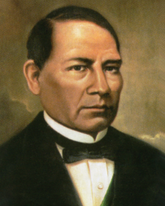Álvarez' cabinet which had included the progressive state governors Benito Juarez and Melchor Ocampo, and the poet Guillermo Prieto represented a new generation of liberals that had grown up since independence, and intended to pass unprecedented reforms during a period which began with the Álvarez administration and would eventually come to be known as La Reforma. The reforms would culminate in the Constitution of 1857, and open conflict with the opponents of the measures which would not entirely end until 1867.
They began with the Ley Juarez, which stripped the Mexican clergy of their independent legal privileges ( fueros ) which they had hereunto enjoyed under canon and civil law. The Ley Juarez was prefaced by the cause celebre of Father Javier Miranda. On 20 November 1855, the former conservative minister, Father Miranda was arrested in his home at Puebla. He was then transported to Mexico City where he was held at the barracks of San Hipolito. [20] This was technically illegal as the government could not at the time imprison a priest without collaboration from church authorities. The conservative press was outraged, and even the liberal press criticized the arrest as arbitrary and advocated for Miranda to be tried and for the government to explain its motives in arresting him. [21] The bishop of Puebla protested to the government, but to no avail. The only response of the government was to transport Miranda to the fortress of San Juan de Ullua in Veracruz Harbor. It was suspected that the arrest was due to Miranda's political views. [22]
The Ley Juarez was passed on 22 November 1855. Ecclesiastical tribunals were stripped of their ability to judge civil law cases. They were allowed to continue judging clergy in the cases of canon law. [23] With Father Miranda's case in mind, conservatives accused this measure as a means of passing severe anti-clerical laws, arresting priests on the slightest pretext, and then judging them in civil courts. [24] Opponents of the measure accused government deputies of hypocrisy for claiming to support equality before the law while maintaining their own immunity. [25]
The Archbishop protested against the measure and suggested that the question of the ecclesiastical fuero should be submitted to the pope, a suggestion which was rejected by the government. The conservative generals Santa Anna and Blanco were officially stripped of their charges and the liberals Degollado and Moreno were commissioned as generals. Comonfort was now threatening to resign and only keep the office of general in chief. Álvarez directed his secretaries to lay before him proposals on how to proceed, he also directed his council to prepare a draft of the organic statute. Meanwhile, the conservatives began to favor the moderate Comonfort for the presidency. [26]
Resignation

Álvarez seriously considered stepping down from the presidency and handing it over to Comonfort, but the latter's enemies urged Álvarez to stay in office. On 4 December, Álvarez summoned a meeting of the most prominent members of the liberal party for advice on how to proceed. He wavered on the matter and on the following day accepted the resignation of his entire ministry and summoned Luis de la Rosa in organizing another. The portfolios would remain empty for the rest of Álvarez' presidency. [27]
In Guanajuato, Manuel Doblado pronounced against the government of Juan Álvarez on 6 December, holding up the moderate Ignacio Comonfort as the new president. His proclamation accused Álvarez of attacking religion, the one thing that bound Mexicans together. [28] This would prove to be redundant, as before news of the revolt even reached the capital, the elderly President Álvarez who was not enjoying administrative tasks or the climate of Mexico City, decided to step down, and he announced as such on 8 December. [29] Álvarez met with Comonfort and officially transferred the presidency to him on 11 December. [30]
Later life
Álvarez left the capital on 18 December, with a military escort and headed to Guerrero where he fought against uprisings opposed to the Comonfort administration. He continued to fight for the liberal cause during the Reform War having the southern states as his base of operations. During the Second French intervention which began in 1861, he counseled President Juarez to keep the struggle alive, and Juarez gave orders for his Eastern forces to obey Álvarez in case they lost contact with the central government. He lived long enough to see the retreat of the French in 1866 and the fall of the Second Mexican Empire in June 1867. Álvarez died the same year on 21 August. [31]
See also
Related Research Articles

The Battle of Puebla, also known as the Battle of May 5 took place on 5 May 1862, near Puebla de los Ángeles, during the second French intervention in Mexico. French troops under the command of Charles de Lorencez repeatedly failed to storm the forts of Loreto and Guadalupe situated on top of the hills overlooking the city of Puebla, and eventually retreated to Orizaba in order to await reinforcements. Lorencez was dismissed from his command, and French troops under Élie Frédéric Forey would eventually take the city, but the Mexican victory at Puebla against a better equipped force provided patriotic inspiration to the Mexicans.
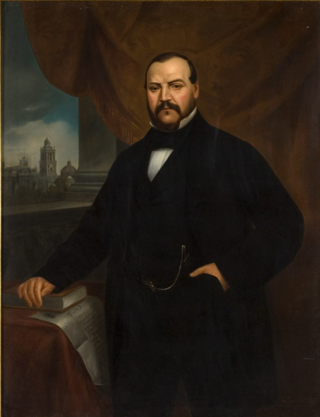
Ignacio Gregorio Comonfort de los Ríos, known as Ignacio Comonfort, was a Mexican politician and soldier who was also president during La Reforma.

Miguel Gregorio de la Luz Atenógenes Miramón y Tarelo, known as Miguel Miramón, was a Mexican conservative general who became president of Mexico at the age of twenty seven during the Reform War, serving between February 1859 and December 1860. He was the first Mexican president to be born after the Mexican War of Independence.

Félix María Zuloaga Trillo (1813–1898) was a Mexican conservative general and politician who played a key role in the outbreak of the Reform War in early 1860, a war which would see him elevated to the presidency of the nation. President Zuloaga was unrecognized by and fought against the liberals supporters of President Benito Juarez.
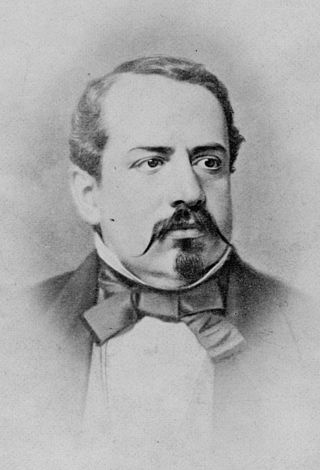
Manuel Robles Pezuela was a military engineer, military commander, and eventually interim president of Mexico during a civil war, the War of Reform, being waged between conservatives and liberals, in which he served as president of the Conservatives, in opposition to President Benito Juarez, head of the Liberals.

Martín Carrera Sabat was a Mexican general, senator, and interim president of the country for about a month in 1855. He was a moderate Liberal.

Manuel María Lombardini de la Torre (1802-1853) was a Mexican soldier who served as president briefly for about three months in 1853. He rose to power in the wake of a revolution against the government of President Mariano Arista. After Arista and his successor Juan Ceballos resigned, the insurgents elevated Lombardini to the presidency as a matter of convenience, and he was only ever meant to serve as a placeholder while the true aim of the insurgents, the restoration of Santa Anna, was carried out. Lombardini would resign accordingly on April 20, and he died of pneumonia in December of the same year.

Juan Bautista Loreto Mucio Francisco José de Asís de la Santísima Trinidad Ceballos Gómez Sañudo (1811-1859) was a Mexican politician who served in congress and in the supreme court before being briefly made president after the resignation of President Mariano Arista during a revolution known as the Plan of Jalisco in 1853. He failed to come to any sort of arrangements with the insurgents and resigned after only about a month of serving and went back to his seat on the supreme court. After being removed from the court by the restored Santa Anna, he left the country and died in Paris in 1859.
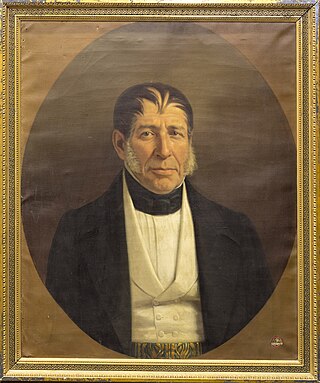
José Joaquín Antonio Florencio de Herrera y Ricardos was a Mexican statesman who served as president of Mexico three times, and as a general in the Mexican Army during the Mexican–American War of 1846–1848.

José Mariano Salas Barbosa was a Mexican soldier and politician who served twice as interim president of Mexico, once in 1846, during the Mexican American War, and once in 1859 during the War of Reform.

José Mariano Epifanio Paredes y Arrillaga was a Mexican conservative general who served as president of Mexico between December 1845 and July 1846. He assumed office through a coup against the liberal administration led by José Joaquín de Herrera. He was the grandfather of 38th Mexican President Pedro Lascuráin Paredes.

Valentín Canalizo Bocadillo, was a Mexican general and statesman who served twice as interim president during the Centralist Republic of Mexico and was later made Minister of War during the Mexican American War.

In the history of Mexico, La Reforma, or reform laws, refers to a pivotal set of laws, including a new constitution, that were enacted in the Second Federal Republic of Mexico during the 1850s after the Plan of Ayutla overthrew the dictatorship of Santa Anna. They were intended as modernizing measures: social, political, and economic, aimed at undermining the traditional power of the Catholic Church and the army. The reforms sought separation of church and state, equality before the law, and economic development. These anticlerical laws were enacted in the Second Mexican Republic between 1855 and 1863, during the governments of Juan Álvarez, Ignacio Comonfort and Benito Juárez. The laws also limited the ability of Catholic Church and indigenous communities from collectively holding land. The liberal government sought the revenues from the disentailment of church property, which could fund the civil war against Mexican conservatives and to broaden the base of property ownership in Mexico and encouraging private enterprise. Several of them were raised to constitutional status by the constituent Congress that drafted the liberal Constitution of 1857. Although the laws had a major impact on the Catholic Church in Mexico, liberal proponents were not opposed to the church as a spiritual institution, but rather sought a secular state and a society not dominated by religion.
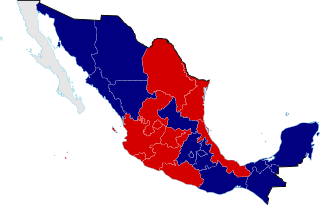
The Reform War, or War of Reform, also known as the Three Years' War, and the Mexican Civil War, was a complex civil conflict in Mexico fought between Mexican liberals and conservatives with regional variations over the promulgation of Constitution of 1857. It has been called the "worst civil war to hit Mexico between the War of Independence of 1810-21 and the Revolution of 1910-20." Following the liberals' overthrow of the dictatorship of conservative Antonio López de Santa Anna, liberals passed a series of laws codifying their political program. These laws were incorporated into the new constitution. It aimed to limit the political power of the executive branch, as well as the political, economic, and cultural power of the Catholic Church. Specific measures were the expropriation of Church property; separation of church and state; reduction of the power of the Mexican Army by elimination of their special privileges; strengthening the secular state through public education; and measures to develop the nation economically.

José Ventura Melchor Ciriaco de Ecay-Múzquiz y Arrieta was a Mexican soldier and politician who became the 5th President of Mexico after president Anastasio Bustamante stepped down to personally lead his armies against an 1832 insurgency known as the Plan of Veracruz.
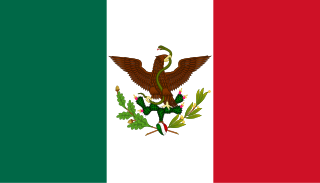
The Second Federal Republic of Mexico refers to the period of Mexican history involving a second attempt to establish a federal government in Mexico after the fall of the unitary Centralist Republic of Mexico in 1846 at the start of the Mexican-American War. It would last up until the Second French Intervention in Mexico led to the proclamation of the Second Mexican Empire in 1863.
The Liberal Party was a loosely organised political party in Mexico from 1822 to 1911. Strongly influenced by French Revolutionary thought, and the republican institutions of the United States, it championed the principles of 19th-century liberalism, and promoted republicanism, federalism, and anti-clericalism. They were opposed by, and fought several civil wars against, the Conservative Party.

The Revolt of the Polkos was a coup d'état in Mexico that was launched on February 27, 1847, during the Mexican-American War. The coup was initiated by militias stationed at the Mexican capital with the aim of overthrowing President Valentin Gomez Farias. It would eventually succeed, and Gomez Farias was replaced by Pedro María de Anaya.
The Conservative Party was a political faction in Mexico between 1823 and 1867, which became a loosely organized political party after 1849.

José María Patoni (1828-1868) was a Mexican liberal military commander and governor of the State of Durango during the Reform War and the Second French Intervention in Mexico.
References
- ↑ Peter Guardino, "Juan Álvarez" in Encyclopedia of Latin American History and Culture, vol. 1, p. 73. New York: Charles Scribner's Sons 1996.
- ↑ Rivera Cambas, Manuel (1873). Los Gobernantes de Mexico: Tomo II (in Spanish). J.M. Aguilar Cruz. p. 477.
- ↑ Rivera Cambas, Manuel (1873). Los Gobernantes de Mexico: Tomo II (in Spanish). J.M. Aguilar Cruz. p. 478.
- ↑ Rivera Cambas, Manuel (1873). Los Gobernantes de Mexico: Tomo II (in Spanish). J.M. Aguilar Cruz. p. 478.
- ↑ Rivera Cambas, Manuel (1873). Los Gobernantes de Mexico: Tomo II (in Spanish). J.M. Aguilar Cruz. p. 478.
- ↑ Rivera Cambas, Manuel (1873). Los Gobernantes de Mexico: Tomo II (in Spanish). J.M. Aguilar Cruz. p. 478.
- ↑ Bancroft, Hubert Howe (1879). History of Mexico volume V: 1824-1861. p. 647.
- ↑ Bancroft, Hubert Howe (1879). History of Mexico volume V: 1824-1861. pp. 648–649.
- ↑ Bancroft, Hubert Howe (1879). History of Mexico volume V: 1824-1861. pp. 648–649.
- ↑ Bancroft, Hubert Howe (1879). History of Mexico volume V: 1824-1861. p. 651.
- ↑ Bancroft, Hubert Howe (1879). History of Mexico volume V: 1824-1861. p. 652.
- ↑ Bancroft, Hubert Howe (1879). History of Mexico volume V: 1824-1861. p. 665.
- ↑ Bancroft, Hubert Howe (1879). History of Mexico volume V: 1824-1861. p. 667.
- ↑ Bancroft, Hubert Howe (1879). History of Mexico volume V: 1824-1861. p. 667.
- ↑ Bancroft, Hubert Howe (1879). History of Mexico volume V: 1824-1861. p. 668.
- ↑ Bancroft, Hubert Howe (1879). History of Mexico volume V: 1824-1861. p. 667.
- ↑ Bancroft, Hubert Howe (1879). History of Mexico volume V: 1824-1861. p. 669.
- ↑ Bancroft, Hubert Howe (1879). History of Mexico volume V: 1824-1861. p. 669.
- ↑ Bancroft, Hubert Howe (1879). History of Mexico volume V: 1824-1861. p. 669.
- ↑ Zamacois, Niceto (1881). Historia de Mexico Tomo XIV (in Spanish). JF Parres. p. 119.
- ↑ Zamacois, Niceto (1881). Historia de Mexico Tomo XIV (in Spanish). JF Parres. p. 120.
- ↑ Zamacois, Niceto (1881). Historia de Mexico Tomo XIV (in Spanish). JF Parres. p. 120.
- ↑ Zamacois, Niceto (1881). Historia de Mexico Tomo XIV (in Spanish). JF Parres. p. 127.
- ↑ Zamacois, Niceto (1881). Historia de Mexico Tomo XIV (in Spanish). JF Parres. p. 127.
- ↑ Zamacois, Niceto (1881). Historia de Mexico Tomo XIV (in Spanish). JF Parres. p. 128.
- ↑ Bancroft, Hubert Howe (1879). History of Mexico volume V: 1824-1861. p. 671.
- ↑ Bancroft, Hubert Howe (1879). History of Mexico volume V: 1824-1861. p. 672.
- ↑ Zamacois, Niceto (1881). Historia de Mexico Tomo XIV (in Spanish). JF Parres. p. 130.
- ↑ Zamacois, Niceto (1881). Historia de Mexico Tomo XIV (in Spanish). JF Parres. p. 132.
- ↑ Bancroft, Hubert Howe (1879). History of Mexico volume V: 1824-1861. p. 673.
- ↑ Rivera Cambas, Manuel (1873). Los Gobernantes de Mexico: Tomo II (in Spanish). J.M. Aguilar Cruz. p. 484.
Further reading
- Bushnell, Clyde G. "The Military and Political Career of Juan Álvarez, 1790-1867". PhD dissertation, University of Texas 1958.
- Guardino, Peter. "Juan Álvarez" in Encyclopedia of Latin American History and Culture, vol. 1, p. 73. New York: Charles Scribner's Sons 1996.
- (in Spanish) De la Cueva, Mariano, ed. et al., Plan de Ayutla. Mexico 1954.
- (in Spanish) Díaz Díaz, Fernando. Caudillos y caciques: Antonio López de Santa Anna y Juan Álvarez. 1952.
- (in Spanish) García Puron, Manuel (1984). México y sus gobernantes, Vol. 2. Mexico City: Joaquín Porrúa.
- (in Spanish) Muñoz y Pérez, Daniel. El general don Juan Álvarez. 1959.
- (in Spanish) Orozco Linares, Fernando (1985). Gobernantes de México. Mexico City: Panorama Editorial. ISBN 968-38-0260-5.
External links
- Biographical details at Letras Libres (in Spanish).
Juan Álvarez | |
|---|---|
 Portrait made by an unknown artist, oil on canvas, Museo Nacional de Historia | |
| 24th President of Mexico |
